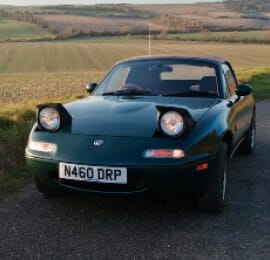First-generation MX5 models were built between 1989 and 1998 and are known as the MK1, or NA. This model’s most distinctive feature is its pop-up headlights, which in the opinion of many fans makes it the most iconic of all generations. Launched in Japan as the Eunos Roadster and in America as the Miata, British cars carried the MX5 name most associate with the model, though many of the surviving examples on UK roads are imported Eunos Roadsters. All are fundamentally the same car, but there are some detail differences to be aware of.

So where did yours come from? On the outside the most obvious clues are whether it carries Mazda or Eunos badges and the shape of the rear number plate recess, which is square on Japanese Domestic Market (JDM) cars and oblong on UK ones. Eunos models imported to the UK also needed a rear fog light, which can be integrated into the light cluster, recessed into the bumper or – more often – mounted below it on a simple bracket. If your car is a US-market Miata the most obvious difference is that the steering wheel will be on the left, though you’ll also see the wings use different panels without the mountings for side indicator repeaters.
Eunos or MX5?
Given the age of the cars and interchangeability of parts it’s possible to ‘rebrand’ a Eunos into an MX5 (or vice versa!) so the sure-fire way to tell is via the Vehicle Identification Number, or VIN. This can be found either on the registration document, or on the metal vehicle identification plate fixed to the bulkhead at the back of the engine bay. All cars built for the UK and European market have a 17-digit number beginning ‘JMZ’ and followed by the ‘NA’ designation. Australian cars (also right-hand drive) begin JM0 while North American cars are JM1. Eunos Roadsters have a simpler, two-part, 10-digit code prefixed by the NA model designation. A full downloadable pdf breakdown of the MX5 chassis number can be found by clicking on the link at the bottom of the page.
Evolution of an icon
Mechanically speaking all Mk1/NA MX5s are fundamentally the same, whichever market they were originally built for. Early models launched with a 115ps 1.6-litre engine which carried on in JDM models, but in the UK was replaced by a 130ps 1.8 in 1993. One to look out for is the later UK-market 1.6, which was reintroduced with a detuned 90hp engine and is the slowest of all Mk1s. Later UK 1.8s gained ABS, driver’s airbag, power steering with a faster rack than the non-assisted versions and electric mirrors, the model remaining more or less unchanged until production ended in 1997 with only the later cars getting the high-level brake light in the boot lid. Most Mk1s use the lovely five-speed manual gearbox, which fans rightly celebrate as an essential part of the car’s character. Automatics are out there but much less desirable.
Special Editions
So much for the simple version – now we get onto the special editions! Throughout all four generations of the MX5, Mazda has enthusiastically embraced the policy of creating limited edition models to help sales and improve desirability and typically featured special paint colours, different wheels and unique interior trim. For UK cars these were created at a ‘local’ level by Mazda’s importer at the time and include the ultra-exclusive Le Mans, of which only 24 were made to celebrate Mazda’s victory at Le Mans in 1991. Painted in the same livery as the winning 787B, these cars also got the BBR turbo, body kit and a wallet with a card signed by Johnny Herbert, one of the winning drivers from the race. Other than that the UK specials are mechanically the same as regular MX5s, though their rarity and the wider range of colours can make them more desirable. Ones to look out for include the Gleneagles, Merlot and California, though there are many others.
The Japanese market got its own array of limited editions, though in some cases these received more extensive modifications, including Bilstein dampers, limited-slip differentials, different gearing and even racing style bucket seats for the coveted RS Limited. These are now very sought-after by MX5 enthusiasts and command a hefty premium, especially in original condition. Just be sure you’re buying what you think you’re buying.
DOWNLOAD MX5 CHASSIS NUMBER GUIDE Looking to buy a Mk1?
